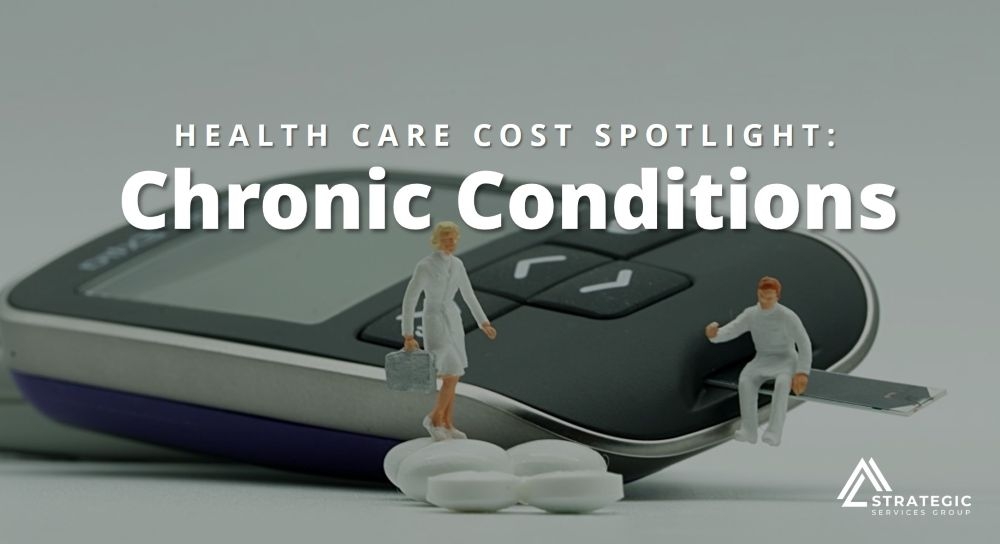Health Care Cost Spotlight - Chronic Conditions

Health care costs are projected to increase substantially this year. According to industry surveys and reports, employers anticipate health care costs to rise by 7% - 8% in 2025. As a result, employer-sponsored health care plans will continue to cost more per employee, impacting employers and employees alike.
The U.S. Centers for Disease Control and Prevention (CDC) reported that treating chronic conditions accounts for a staggering 90% of the nation’s health care costs. Furthermore, an increasing percentage of the population has two or more chronic, high-cost diseases. This Health Care Cost Spotlight insight focuses on chronic conditions and how they’re impacting health care costs this year and beyond.
Types of Chronic Conditions
According to the CDC, 6 in 10 Americans have at least one chronic disease, and 4 in 10 have two or more chronic diseases. A chronic disease is defined as a health condition that requires ongoing management over an extended period of time. Some chronic conditions have very few symptoms, while others severely limit a person’s ability to perform routine tasks. In general, chronic disease is increasing in prevalence in the United States and is projected to continue to do so in 2025 and the upcoming decades.
There are many chronic conditions affecting the workforce today, some of the most common being:
- Arthritis: Arthritis is not a single disease but a term used to describe joint pain or disease. There are currently over 100 different recognized types of arthritis in the United States, affecting 58.5 million Americans. The National Health Interview Survey cites arthritic conditions as the most common cause of disability in the United States. Treating arthritis often involves prescription and specialty drugs—two things that come at a high expense.For example, biologic drugs, which are typically prescribed for treating rheumatoid arthritis, cost about $1,000 to $3,000 per month. Even after insurance, the cost of treating arthritic conditions adds up quickly.
- Cardiovascular Disease: Heart disease is a lifelong condition and can include any type of disease of the heart or blood vessel system. Having heart disease increases your likelihood of suffering a heart attack or a stroke or developing additional chronic diseases. Cardiovascular disease costs the United States more than $216 billion each year in health care expenses.
- Obesity: The CDC reported that more than 2 in 5 adults in the United States have obesity, which is defined as having a body mass index of 30 or higher. Over the past few decades, obesity rates in the United States have gone up dramatically. The CDC found that during August 2021-23, the prevalence of obesity in adults was 40.3%. According to the agency, this is an increase of over- 10% from a 1999-2000 study.
- Type 2 Diabetes: Unlike Type 1 diabetes, also known as juvenile diabetes, people with Type 2 diabetes make insulin but are unable to process it correctly. Because of this, individuals with Type 2 diabetes have to purchase special medicine and tools to manage their condition. According to the American Diabetes Association, treating diabetes and prediabetes costs over $327 billion per year. In addition to higher medical costs, having diabetes puts you at higher risk for other serious health conditions like gum disease, glaucoma and kidney disease.
Chronic and mental conditions are closely connected. While some people may experience a couple of short episodes, others may manage their mental health condition consistently throughout their lives. While the severity of mental health conditions can fluctuate, they are often persistent, which would make mental illness chronic. Also, mental illnesses and other chronic conditions often co-occur. Receiving the diagnosis of a chronic illness can be life-altering, triggering strong emotions like grief and sadness. Still, treatment may be focused on the primary condition and not the mental challenges. For example, the CDC notes that Americans who have diabetes are two to three times more likely to develop depression than those without diabetes; however, only 25%-50% of people with diabetes and depression get diagnosed and treated for both.
When considering chronic diseases, employers should account for all types of physical and mental conditions requiring lifelong management and treatment.
Causes of Chronic Conditions
Although genetics may be a contributing factor, unhealthy habits like a lack of exercise, tobacco use, excessive alcohol use and poor nutrition are often the main reasons for developing these chronic health problems. Experts suggest that in 90% of cases, chronic conditions could have been prevented with proper lifestyle changes, such as avoiding smoking, exercising regularly, maintaining a healthy weight, managing stress and receiving routine preventive care. Read More.
The Cost of Chronic Conditions
When left unchecked and unmanaged—for weeks, months or years—chronic conditions can result in serious illness, hospitalization and death. In addition, treating chronic conditions may involve physician visits, extended hospital stays, prescription drugs and expensive treatments, contributing to increased medical expenditures and lost productivity for employers. Read More.
As previously mentioned, the CDC reports that 90% of the nation’s $4.5 trillion in annual health care costs are for people with chronic and mental health conditions.
Cost-Mitigation Strategies for Employers
On average, employer health care coverage for an employee with a chronic condition is five times higher than coverage for those without a chronic disease. So, what can employers do to reduce health care costs for themselves and their employees? Think prevention.
Approximately 133 million Americans live with one or more chronic diseases, which translates into an increased cost for employers.
Treating chronic diseases involves physician visits, extended hospital stays, prescription drugs and expensive treatments. Prevention is the most cost-effective method of reducing chronic diseases among at-risk employees. To assist in prevention efforts, employers should implement workplace policies that encourage employees to use preventive services and health promotion programs. Read More.

 Prev
Prev

